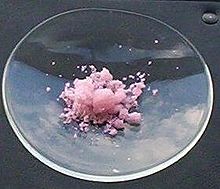Erbium(III) chloride

| |
| Names | |
|---|---|
| IUPAC name
Erbium(III) chloride
| |
| Other names
Erbium trichloride
| |
| Identifiers | |
| |
3D model (JSmol)
|
|
| ChemSpider | |
| ECHA InfoCard | 100.030.337 |
| EC Number |
|
PubChem CID
|
|
| UNII | |
CompTox Dashboard (EPA)
|
|
| |
| |
| Properties | |
| ErCl3 (anhydrous) ErCl3·6H2O (hexahydrate) | |
| Molar mass | 273.62 g/mol (anhydrous) 381.71 g/mol (hexahydrate) |
| Appearance | violet hygroscopic monoclinic crystals (anhydrous) pink hygroscopic crystals (hexahydrate) |
| Density | 4.1 g/cm3 (anhydrous) |
| Melting point | 776 °C (1,429 °F; 1,049 K) (anhydrous) decomposes (hexahydrate) |
| Boiling point | 1,500 °C (2,730 °F; 1,770 K) |
| soluble in water (anhydrous) slightly soluble in ethanol (hexahydrate)[1] | |
| Structure[2] | |
| monoclinic | |
| C2/m, No. 12 | |
a = 6.80 Å, b = 11.79 Å, c = 6.39 Å α = 90°, β = 110.7°, γ = 90°
| |
Lattice volume (V)
|
479 Å3 |
Formula units (Z)
|
4 |
| Related compounds | |
Other anions
|
Erbium(III) oxide |
Other cations
|
Holmium(III) chloride, Thulium(III) chloride |
Except where otherwise noted, data are given for materials in their standard state (at 25 °C [77 °F], 100 kPa).
| |
Erbium(III) chloride is a violet solid with the formula ErCl3. It is used in the preparation of erbium metal.
Preparation
[edit]
Anhydrous erbium(III) chloride can be produced by the ammonium chloride route.[3][4][5] In the first step, erbium(III) oxide is heated with ammonium chloride to produce the ammonium salt of the pentachloride:
- Er2O3 + 10 [NH4]Cl → 2 [NH4]2ErCl5 + 6 H2O + 6 NH3
In the second step, the ammonium chloride salt is converted to the trichloride by heating in a vacuum at 350-400 °C:
- [NH4]2ErCl5 → ErCl3 + 2 HCl + 2 NH3
Structural data
[edit]Erbium(III) chloride forms crystals of the AlCl3 type, with monoclinic crystals and the point group C2/m.[2]
Erbium(III) chloride hexahydrate also forms monoclinic crystals with the point group of P2/n (P2/c) - C42h. In this compound, erbium is octa-coordinated to form [Er(H2O)6Cl2]+ ions with the isolated Cl− completing the structure.[6]
Optical properties
[edit]Erbium(III) chloride solutions show a negative nonlinear absorption effect.[7][clarification needed]
Catalytic properties
[edit]The use of erbium(III) chloride as a catalyst has been demonstrated in the acylation of alcohols and phenols[8] and in an amine functionalisation of furfural.[9] It is a catalyst for Friedel–Crafts-type reactions, and can be used in place of cerium(III) chloride for Luche reductions.[10]
References
[edit]- ^ Lide, David R. (1998). Handbook of Chemistry and Physics (87 ed.). Boca Raton, Florida: CRC Press. pp. 4–57. ISBN 0-8493-0594-2.
- ^ a b Tempelton DH, Carter GF (1954). "The Crystal Structure of Yttrium Trichloride and Similar Compounds". J Phys Chem. 58 (11): 940–943. doi:10.1021/j150521a002.
- ^ Brauer, G., ed. (1963). Handbook of Preparative Inorganic Chemistry (2nd ed.). New York: Academic Press.
- ^ Meyer, G. (1989). "The Ammonium Chloride Route to Anhydrous Rare Earth Chlorides—The Example of Ycl 3". The Ammonium Chloride Route to Anhydrous Rare Earth Chlorides-The Example of YCl3. Inorganic Syntheses. Vol. 25. pp. 146–150. doi:10.1002/9780470132562.ch35. ISBN 978-0-470-13256-2.
- ^ Edelmann, F. T.; Poremba, P. (1997). Herrmann, W. A. (ed.). Synthetic Methods of Organometallic and Inorganic Chemistry. Vol. VI. Stuttgart: Georg Thieme Verlag. ISBN 978-3-13-103021-4.
- ^ Graebner EJ, Conrad GH, Duliere SF (1966). "Crystallographic data for solvated rare earth chlorides". Acta Crystallographica. 21 (6): 1012–1013. doi:10.1107/S0365110X66004420.
- ^ Maeda Y, Akidzuki Y, Yamada T (1998). "All-optical liquid device derived from negative nonlinear absorption effect in an erbium chloride solution". Applied Physics Letters. 73 (17): 2411–2413. Bibcode:1998ApPhL..73.2411M. doi:10.1063/1.122450.
- ^ Dalpozzo Renato, De Nino Antonio, Maiuolo Loredana, Oliverio Manuela, Procopio Antonio, Russo Beatrice, Tocci Amedeo (2007) Erbium(iii) Chloride: a Very Active Acylation Catalyst. Australian Journal of Chemistry 60, 75-79. doi:10.1071/CH06346
- ^ Synthesis of trans-4,5-Bis-dibenzylaminocyclopent-2-enone from Furfural Catalyzed by ErCl3·6H2O Mónica S. Estevão, Ricardo J. V. Martins, and Carlos A. M. Afonso Journal of Chemical Education 2017 94 (10), 1587-1589 {DOI|10.1021/acs.jchemed.6b00470}
- ^ Luche, Jean-Louis (2001-04-15), "Erbium(III) Chloride", in John Wiley & Sons, Ltd (ed.), Encyclopedia of Reagents for Organic Synthesis, Chichester, UK: John Wiley & Sons, Ltd, pp. re006, doi:10.1002/047084289x.re006, ISBN 978-0-471-93623-7
